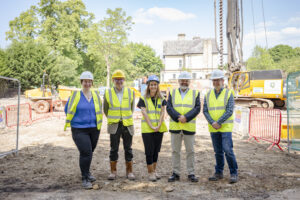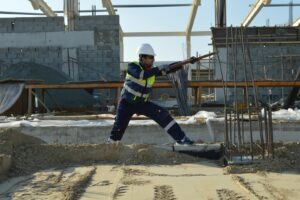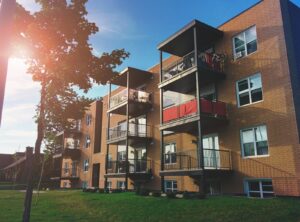
Lilac communal housing, Leeds
Loneliness is becoming one of the greatest public health crises of our time.
According to recent figures by the Office for National Statistics, 2.4 million British residents of all ages suffer from chronic loneliness. Not only is this bad for our mental health, but loneliness is linked to a range of physical health problems, such as heart disease and strokes.
The design of our cities and homes can contribute to isolation, particularly when the number of people who live alone is on the rise, with more than a quarter of all UK households containing one person.
Now, a growing faction of initiatives across the UK are aiming to tackle loneliness. Communal housing, or co-housing, is rising in popularity with the young and old and offers people a sense of community while maintaining their independence.
The idea first started in Denmark in the 1960s, but there are now around 20 established co-housing schemes in the UK and many more in development.
Community
Lara Eggleton, 38, moved to Lilac (Low Impact Living Affordable Community) in Leeds four years ago after living on her own in a flat for nine years. The community consists of 20 eco-build households situated around shared space where residents can interact with one another.
‘There’s the common house, it’s a house that everyone uses that is like an extension of your front room,’ she says.
‘You can book things in for private things, or we use it for shared meals and there’s a projector. We do everything from yoga to film screenings. We have a post room and laundry facilities, and workshops.
‘It benefits wellbeing in so many ways. I was alone a lot before, apart from when I arranged to meet with people. I could choose when I wanted to be social but otherwise I just stayed in my box. I think that had an affect on my mental health,’ Ms Eggleton adds.
‘Because of the way Lilac is built, people knock on your door, you have to go to the common house to get your post or laundry and you bump into someone and stop to chat. It’s that kind of day to day interaction.’
It isn’t just the adults that benefit from living in a co-housing community, but children too. ‘Everyone’s kids are growing up together,’ Ms Eggleton says, adding that childcare is shared between residents when needed too.
‘We just have a play area on site, with a treehouse, they ride their scooters together.’
Wellbeing in design
Thousands of new apartment blocks are springing up all over the UK. Despite many of us living in close confinement with one another, we rarely know our neighbours and continue to live solitary lives.
To combat this, councils and developers say they are no longer simply focusing on the number of homes being built, but also the impact of design on residents’ wellbeing, including better communal spaces.
Derek Antrobus, a councillor at Salford City Council, says wellbeing is a ‘really important issue’ that is key factor in approving large regeneration schemes. Earlier this year, plans for nearly 300 new homes in Salford were given the green light by the council, the majority of which will be one or two-bedroom flats.
‘We encourage developers to think about creating good communal spaces inside and outside their developments to give people the chance to gather and meet,’ he explains.
‘We recently turned down one high rise block because we felt the development would lead to isolation. The developer came back with a proposal which included a community room and a more accessible shared garden for the residents.’
In Liverpool, nearly 2,000 new homes are set to be built over the next two years. While the council doesn’t explicitly ‘discuss loneliness’ among residents, according to communications manager Mike Doran, it does seek to ‘promote the health’ of future and existing residents.
‘An individual’s physical and mental wellbeing is an important issue and the impact that a new development will have on this is a material consideration in Liverpool’s planning process,’ he says.
New accommodation is designed to be accessible, light and offer privacy, he adds, as well as green space – which research has shown benefits mental health.
Andy Phillips, commercial director at residential property consultancy Knight Knox, said the focus is on enhancing the lives of residents when planning a development.
‘Our aim is to create communities, not just accommodation,’ he says. ‘With that in mind, we always try our best to include communal spaces for residents, which externally includes elements like rooftop terraces, courtyards and central gardens, while internally it’s cinema rooms and private gyms, which are really popular.
‘We also work with our developer partners to hold regular social events for residents so they can mingle and get to know one another.’
Flexible living
Although combating social isolation is becoming a factor in new housing developments, co-housing offers the added bonus of flexible living – which can also benefit wellbeing. After Ms Eggleton gave birth last year, her family was able to move from their two-bedroom flat in Lilac into three-bedroom house because another member was looking to downsize.
Rising rental costs is a cause of stress for many of us, but Lilac uses a unique financial model that ensures permanent affordability as the homes and land are managed by residents through a Mutual Home Ownership Society.
The company sells shares to members when they move in – the number of shares equates to the size of their property and a proportion of the common house – and buys them back when they move out.
After deductions for maintenance and insurance, these payments pay the mortgage. The payment that leaseholders pay each month is set at around 35% of net income.
‘I am self-employed in the arts, so my income isn’t particularly high and I only ever pay the same percentage of what I earn as anybody else at Lilac,’ Ms Eggleton says.
‘I adjusted my payments when I had a baby for Lilac accordingly, which doesn’t happen anywhere else. It’s really flexible. If someone loses their job, or has an emergency, or has an accident, then they are supported by others in the community.’
Challenges
This isn’t to say there aren’t challenges that come with co-housing schemes. Critics argue the trend is a response to high house prices and skyrocketing rents in cities, which remains a problem for the majority of Britons.
Living in a co-housing community isn’t always plain-sailing, either, says Ms Eggleton, particularly as Lilac is a co-op scheme and not just housing.
‘We do everything through decision-making, which can take a lot of time. We have to keep meeting until everyone is happy. Sometimes it feels like a bit too much, when you’re working and have a family.
‘There have been moments when I miss just paying rent and not worrying about anything else,” she says.
‘But the pay off for me is huge, I’ve never had any second thoughts [about moving here].
‘You are building something together and it takes work. It’s about spending time with your neighbours, having communal meals. That’s the work we have forgotten how to do in society. I think we can live healthier more well-rounded lives.’


















Leave a Reply